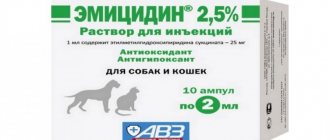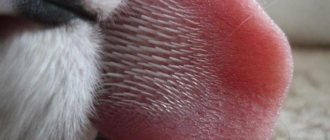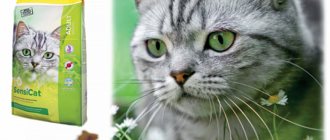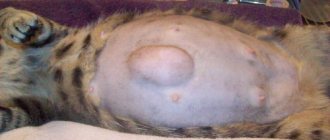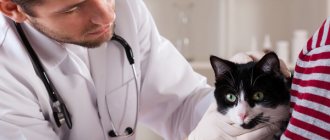Shortness of breath in a cat More often it is caused physiologically, less often it occurs due to health problems. It is important for the owner to be able to distinguish the first from the second in order, if necessary, to promptly seek help from a veterinarian. Persistent and progressive respiratory failure can lead to the death of the pet.
Shortness of breath in a cat
Signs of a breathing disorder
You can guess that a cat has health problems if, while breathing:
- wheezing or whistling is heard;
- air is captured and released with difficulty;
- the animal sits in an unusual position, is worried, tries to lie down, but is suffocating, so it gets up again and again;
- the animal breathes with its mouth slightly open and it is clear that the mucous membranes of the gums and lips are pale pink or bluish in color;
- the frequency of inhalations and exhalations is noticeably higher or lower than normal.
Breathing with your mouth slightly open is a sure sign of shortness of breath
On a note! The body of animals living on land is designed in such a way that it does not accumulate precious oxygen, but receives it in the current mode from the air, through respiratory movements. If the process is disrupted for some reason, the animal’s life is endangered.
Signs of danger
The combination of this condition in an animal with an increased need to drink water requires urgent medical intervention.
The following signs indicate an urgent visit to the veterinarian:
- temperature increase;
- body position when the cat lies on its stomach, legs spread out and neck stretched out;
- confusion or loss of consciousness;
- impaired coordination of movements;
- increased thirst;
- lethargy, refusal to play;
- wheezing and whistling during inhalation or exhalation;
- cyanosis or pallor of mucous membranes;
- violation of the frequency of respiratory movements.
Types of shortness of breath
Breathing difficulties in cats caused by diseases are classified into:
- bradypnea - rare breathing that occurs due to insufficient functioning of the corresponding center of the brain;
- tachypnea - frequent, shallow breathing - one of the signs of fever, and possibly blood pathologies.
Depending on the phase that is affected, shortness of breath is defined as:
- inspiratory, when breathing is difficult;
- expiratory, if there are problems with exhalation;
- mixed, when both phases suffer.
Normal respiratory rate per minute in cats
Treatment: how to act correctly?
If natural shortness of breath begins to appear frequently, but there are no obvious signs of the disease, you should have your pet examined by a doctor, since some diseases have a hidden course in the early stages.
The treatment regimen is determined by the veterinarian individually depending on the etiology of shortness of breath. If the problem of rapid breathing is associated with nasal polyps, they are removed through surgery. Surgery is necessary for oncology in the sternum organs. For cardiac dirofilariasis, antiparasitic drugs are prescribed - Stronghold, Ditiazanin, Levamisole, Mebendazole. Medicines are very toxic, especially for a kitten, so the dosage should be strictly observed. Mycoses are treated with antifungal agents after the type of pathogen has been identified.
If a cat's shortness of breath is caused by pulmonary edema, the pet is prescribed diuretics and oxygen therapy procedures. Pacemakers are effective for cardiovascular diseases. Treatment of viral pneumonia includes antiviral drugs, such as Forvet, Maxidin, Ribaflox, and for bacterial pneumonia, antibiotics help - Amoxicillin, Spiramycin, Ampicillin. The accumulation of fluid in the pleural cavity is cured by the procedure of thoracentesis. Treatment of anemia includes iron supplements and strengthening vitamin supplements. For asthma, inhalations are recommended. If the cat is overheated, you should place it in a cool, shaded place and wipe it with cold water.
Physiologically caused shortness of breath
It is characterized by the fact that:
- is caused by natural processes of the body’s vital functions and does not require treatment;
- essentially represents a reaction to the influence of stress factors or unfavorable conditions, after which the respiratory process in the animal returns to normal.
Causes
A physiological respiratory disorder develops in an animal when:
- Psycho-emotional stress. It is accompanied by the release of a large amount of adrenaline into the blood, which stimulates the heart. The body's need for oxygen increases sharply. To compensate for its deficiency, the cat begins to breathe more often and deeper.
A cat's breathing may be impaired due to psycho-emotional stress.
- Physical stress . When an animal runs a lot and quickly, the heart contracts more often, oxygen is consumed faster, so the cat breathes more actively than at rest. The same thing happens if the animal overheats.
- Stress due to chest injury. The injured pet, in addition to being frightened, experiences pain, which, if the ribs are broken, intensifies with breathing. Inhalations and exhalations become careful, superficial, and the animal’s mouth is open. The situation is critical and requires emergency measures.
Shortness of breath may occur due to chest trauma
Symptoms
We are talking about the behavior of a cat when shortness of breath can be explained by physiological reasons:
- the animal is worried about thirst and drinks a lot after active games and running;
- the pet becomes lethargic, looks for shade to hide and rest, and if it finds a wet surface, it lies down on it. This happens after a long stay in the heat. After a couple of hours, the cat comes to his senses, eats with pleasure and continues to lead an active lifestyle;
- the animal is restless and shows obvious signs of fright, one of which is dilated pupils. Perhaps you had to run away from the dog.
A cat's lethargic state indicates problems with the cat's health.
Attention! Such manifestations are considered a physiological norm when they are caused by appropriate circumstances.
How to help a cat
She needs to be left alone, offered a bowl of fresh, cool water, and then given the opportunity to rest and sleep.
Pathological causes of tachypnea
Sometimes a cat breathes heavily because it is sick. The number of breaths per minute increases noticeably, the mouth is open, the sides rise and fall heavily. The cat seems to be short of air. In some cases this is what happens. For example, when a furry pet develops asthma.
Pathological causes of rapid breathing in a cat can be:
- blood diseases;
- ascites (excess fluid in the abdominal cavity);
- development of various myalgia (heart pathologies);
- airway spasm;
- lung diseases;
- increased pressure inside the abdominal cavity;
- foreign object inside the respiratory tract, trachea or bronchi;
- malignant neoplasms;
- painful growth of some organs.
Important! If a cat has difficulty breathing, only a specialist can determine the exact cause of the animal’s strange condition. Self-diagnosis is usually wrong. This results in the loss of valuable time for treating the pet.
If there is a suspicion that a cat has developed a respiratory pathology, experts advise paying attention to the appearance of the animal. If your cat's ears are flattened, he is overexcited, attacks or tries to hide, he may be under stress.
A frightened or irritated cat almost always breathes from its belly. But as soon as he calms down, breathing returns to normal. There is no need to treat such an animal.
Risk group
There are cat breeds that are prone to breathing problems. These animals were bred using multi-level selection, focusing on the most beautiful appearance. The result was a phenotype with characteristic features of the skull shape. This negatively affected the internal structure of some organs of the respiratory system. Such cats were called brachycephalic.
Persian, Himalayan, British, exotic and Scottish cats have wide muzzles, a characteristic nose shape, the larynx, trachea and jaw of animals are disproportionate to the length of the tongue. This combination is called brachycephalic syndrome (BAOS).
If your cat is brachycephalic, you need to handle him especially carefully, making sure that the animal does not overheat or become physically overtired. Such cats were unlucky from birth: their narrowed nasal openings are not able to ensure normal breathing. To inhale, animals exert certain efforts, which cause an even greater narrowing of the lumens of the nostrils. The airways are pulled inward.
Difficulty inhaling leads to stretching of the animal's laryngeal mucosa. The trachea of brachycephals is initially narrowed, and the palate is longer than that of an ordinary cat. All this negatively affects the functioning of the lungs and increases the load on the heart.
Moments of tension, sometimes even ordinary games, cause sniffling, bubbling in the chest, and coughing in brachycephalic pets. It is impossible to miss such symptoms. They signal the onset of the disease. This is the case when physical abnormalities sooner or later lead to illness.
Important! If a cat develops characteristic breathing difficulties, you should immediately take your pet to a veterinarian. Delay in the visit causes an increase in negative symptoms in the animal.
Respiratory system diseases
When a cat breathes from its belly, there are signs that its lungs are not receiving enough oxygen. The cause may be an infectious-inflammatory disease of the respiratory tract.
As a rule, furry pets get sick:
- rhinitis;
- tracheitis;
- bronchitis.
The cat's body actively fights infectious agents. Mucus is secreted, which contains many leukocytes. This is a normal reaction of the animal's immune system. However, mucus in the respiratory tract interferes with the normal process of obtaining oxygen, so the cat (or kitten) often breathes from its stomach.
A sick pet coughs and mucus comes out of its nose. As a rule, this is accompanied by high fever and an unpleasant odor from the patient’s mouth. The kitten is lethargic and suffers from diarrhea and vomiting. Ulcers form on the oral mucosa. A sick animal begins to wheeze and wheeze when breathing, cough, and sneeze.
Important! If the kitten is breathing heavily and its condition does not return to normal within a few hours, a visit to the veterinarian is required.
Non-infectious causes
It happens that a cat is breathing heavily due to an illness that is not associated with infection. For example, these could be problems with the soft palate or larynx (spasm, swelling).
Abdominal breathing syndrome is caused by the following pathologies:
- helminthiases;
- accumulation of fluid inside the chest cavity (hydrothorax);
- hiatal hernia;
- accumulation of air in the chest cavity (pneumothorax);
- inflammation of the sinuses.
Important! If, a few days after the operation, the cat continues to have difficulty breathing, the animal suffers from shortness of breath, it is necessary to urgently call a doctor. It would also be a good idea to check the condition of your pet’s gums, lips and nose. A bluish tint to the surfaces indicates the development of complications in the heart or respiratory system.
Diseases that are not associated with pathologies of the respiratory system
If a cat has damage to the spine, sternum or ribs, he will have difficulty standing up and try not to strain his chest by breathing. An injured animal breathes shallowly (through the stomach). He develops shortness of breath.
In this state, the cat does not allow you to touch the sore spots, meows loudly, and sometimes loses consciousness. He should be taken to the clinic urgently. Most injuries can only be treated with surgery.
Myalgia
Some cat breeds are predisposed from birth to developing cardiovascular pathologies. These are Maine Coons, British and Persian pets. But other members of the cat family often suffer from heart disease.
The first symptom of the development of myalgia in a cat is abdominal breathing. Then wheezing appears, the skin on the body turns pale, and the mucous membranes in the mouth become blue.
The cat is lethargic, does not eat anything, lies constantly, and breathes heavily. The animal quickly weakens, its heart beats strongly even in the absence of physical activity.
Important! If your cat is diagnosed with heart failure, you will need to give her an injection of a prescribed drug when an attack occurs. Then take it out into the fresh air.
The owner of a cat suffering from myalgia must be prepared to provide emergency assistance if breathing stops during an attack. Vigorously blowing air into the nose through cupped palms will help.
The effectiveness of assistance will increase if artificial respiration is alternated with chest compressions. But it’s best to have the doctor’s phone number handy.
Overheating
Sometimes the cat pant frequently due to the heat. If immediate action is not taken, the animal may suffer from heatstroke. Signs of overheating are:
- Temperature more than 40 degrees.
- Reddened mucous membranes.
- Rapid pulse.
- Predominantly recumbent position of the animal, the cat lies, breathes heavily, sticks out its tongue.
The amount of sweat that is secreted by the skin of a furry pet is unable to cool its body to normal temperature. To reduce body temperature, the cat opens its mouth and breathes heavily. For cats of exotic breeds, British, Scottish, Persian cats, an acceleration of the breathing rhythm in hot weather is considered normal.
Oncology
The clinical picture of this disease depends on the degree of development of the pathology, its type and location. Signs of the disease are:
- loss of appetite;
- decreased physical activity;
- increasing sleep time;
- weight loss.
A sick cat develops shortness of breath and its fur loses its shine. As the tumor grows, the animal wheezes and coughs more and more.
Prevention recommendations
Considering that there can be many causes of respiratory disorders in cats, prevention comes down to maintaining the normal health of the pet. When it is at the proper level, the animal is hardy and gets sick less often. In this regard, it is recommended:
- Feed the cat regularly and in a balanced manner so that it receives the required amount of proteins, vitamins and minerals. The optimal diet will be premium and super premium ready-made food;
- make sure that in the summer the animal has somewhere to hide from the heat and heat, and also drink plenty of fresh water;
- do not overfeed your pet and do not force it to run or play after eating;
- Monitor your cat's health.
How to feed a cat
Attention! If he begins to breathe heavily, you should not expect that “everything will go away on its own.” If you suspect a pathology, you should show the animal to a veterinarian, and then follow all his recommendations with precision.
First aid
Signs that your cat needs emergency help:
- frequent difficulty breathing with an open mouth or sticking out tongue, like a dog, abdominal inhalation;
- sounds uncharacteristic for a pet (wheezing);
- unusual unnatural pose;
- the pet is lying down and cannot get up;
- anxiety, fear, aggressiveness, lethargic pet;
- pallor and blueness of the mucous membranes (gums, lips, tongue).
If these symptoms are detected, it is necessary to urgently take the cat to a veterinary clinic.
It is strictly forbidden to administer human medications or perform any procedures on your own. This group of products is completely unsuitable for use in animals and can cause irreparable harm to health.
